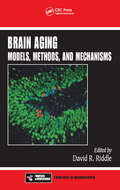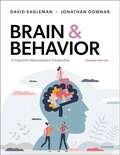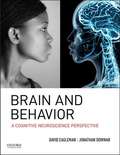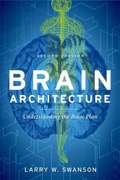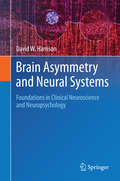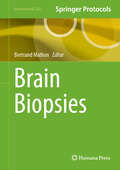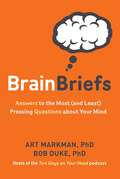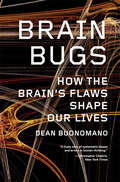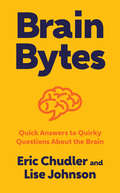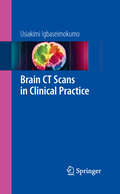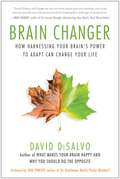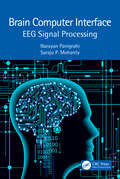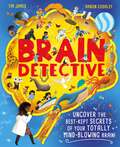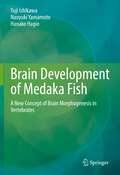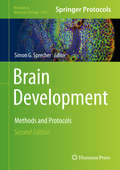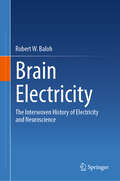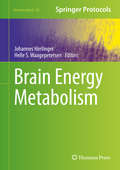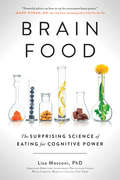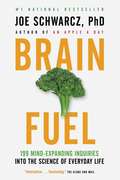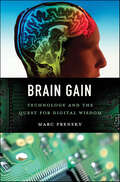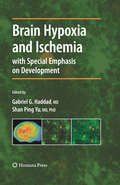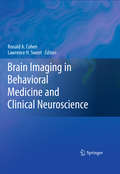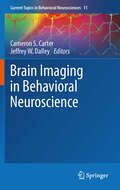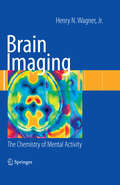- Table View
- List View
Brain Aging: Models, Methods, and Mechanisms
by David R. RiddleRecognition that aging is not the accumulation of disease, but rather comprises fundamental biological processes that are amenable to experimental study, is the basis for the recent growth of experimental biogerontology. As increasingly sophisticated studies provide greater understanding of what occurs in the aging brain and how these changes occur
Brain And Behavior
by David Eagleman Jonathan DownarBrain and Behavior seeks to tell the story of the brain in a logical, engaging, and meaningful way. By exposing overarching principles rather than simply listing facts, Brain and Behavior highlights what we understand about the function of the brain and what we have left to learn. This text makes clear the current thinking in the field and builds the scaffolding for the student to learn new concepts. Without compromising important ideas, this book covers a wide swath of territory critical for understanding the brain, from the basics of the nervous system to sensory and motor systems, the frontal lobes, sleep, language, memory, drug addiction, and brain disorders. Throughout the book, the narrative emphasizes the dynamically changing nature of the brain (neuroplasticity) using clear writing and real-life examples.
Brain And Behavior: A Cognitive Neuroscience Perspective
by David Eagleman Jonathan DownarBrain and Behavior addresses the central aims of cognitive neuroscience, examining the brain not only by its components but also by its functions. Emphasizing the dynamically changing nature of the brain, the text highlights the principles, discoveries, and remaining mysteries of moderncognitive neuroscience to give students a firm grounding in this fascinating subject.
Brain Architecture: Understanding the Basic Plan
by Larry W. SwansonNow in its second edition, Brain Architecture is the continued exploration of how the brain works. At the very core of our existence, the brain generates our thoughts and feelings, directs our voluntary interactions with the environment, and coordinates all of the vital functions within the body itself. This long-overdue new edition explains this oftentimes daunting intricacy and exquisite detail. The first half of the book discusses the basic parts and how they work, presenting an overview of the nervous system at both the microscopic and macroscopic levels. The approach follows three classic lines of thought that proceed from simple to complex: the history of neuroscience research, the evolution of the nervous system, and the embryological development of the vertebrate central and peripheral nervous systems. The second half of the book outlines the basic wiring diagram of the brain and nervous system-how the parts are interconnected and how they control behavior and the internal state of the body. This is done within the framework of a new four-system network model that greatly simplifies understanding the structure-function organization of the nervous system. Written in clear and sparkling prose, beautifully illustrated, and thoroughly updated,Brain Architecture, Second Edition is must-read for anyone interested in the science of how the brain works.
Brain Asymmetry and Neural Systems: Foundations in Clinical Neuroscience and Neuropsychology
by David W. HarrisonThe proposed book investigates brain asymmetry from the perspective of functional neural systems theory, a foundational approach for the topic. There is currently no such book available on the market and there is a need for a neuroscience book, with a focus on the functional asymmetry of these two integrated and dynamic brains using historical and modern clinical and experimental research findings with the field. The book provides evidence from multiple methodologies, including clinical lesion studies, brain stimulation, and modern imaging techniques. The author has successfully used the book in doctoral and advances undergraduate courses on neuroscience and neuropsychology. It has also been used to teach a course on the biological basis of behavior and could be used in a variety of contexts and courses.
Brain Biopsies (Neuromethods #223)
by Bertrand MathonThis volume brings forth a comprehensive exploration of all aspects of cerebral and intracranial biopsies designed to serve as an essential tool for clinicians, researchers, and medical students involved in the care and study of patients with brain disorders. The chapters in this cover a wide array of topics such as surgical techniques for performing brain biopsies, including approaches to both cerebral and skull base biopsies; protocols for handling biopsy samples, focusing on their use for histomolecular diagnosis; indications and outcomes of brain biopsies in patients with brain tumors and those with cryptogenic neurological disease; perioperative management of patients undergoing brain biopsy; and a discussion on the latest innovations and research in this rapidly growing field. In the Neuromethods series style, chapters include the kind of detail and key advice from the specialists needed to get successful results in your neurosurgery unit, or laboratory.Cutting-edge and comprehensive, Brain Biopsies is a valuable resource for anyone involved in the care of patients requiring brain biopsies, from neurosurgeons, neurologists, radiologists, and pathologists.
Brain Briefs: Answers to the Most (and Least) Pressing Questions about Your Mind
by Art Markman Bob DukeWhy do we love kitten videos so much? Does time speed up as we get older? Should we play brain games? Can we make ourselves happy? Art Markman and Bob Duke, hosts of the popular Austin-based KUT radio show and podcast Two Guys on Your Head, are here to answer all your questions about how the brain works and why we behave the way we do. Featuring the latest empirical findings, this is science served up in fun and revelatory bite-size bits, along with a complete set of references for further study.
Brain Bugs: How The Brain's Flaws Shape Our Lives
by Dean Buonomano"Excellent. . . . [Buonomano] reveals the intricate limitations and blessings ?of the most complex device in the known universe."--The Atlantic The human brain may be the best piece of technology ever created, but it's far from perfect. Drawing on colorful examples and surprising research, neuroscientist Dean Buonomano exposes the blind spots and weaknesses that beset our brains and lead us to make misguided personal, professional, and financial decisions. Whether explaining why we are susceptible to advertisements or demonstrating how false memories are formed, Brain Bugs not only explains the brain's inherent flaws but also gives us the tools to counteract them.
Brain Bytes: Quick Answers to Quirky Questions About the Brain
by Eric Chudler Lise A. JohnsonNeuroscience in small bits for the brain-curious. From magazine covers to Hollywood blockbusters, neuroscience is front and center. This popular interest has inspired many questions from people who wonder just what is going on in the three pounds of tissue between their ears. In Brain Bytes, neuroscience educators Eric Chudler and Lise Johnson get right to it, asking and answering more than one hundred questions about the brain. Questions include: Does size matter (do humans have the largest brains)? Can foods make people smarter? Does surfing online kill brain cells? Why do we dream? Why can’t I tickle myself? Why do cats like catnip? Why do we yawn and why are yawns contagious? What can I do to keep my brain healthy? Whether you are interested in serious topics like the history of neuroscience or practical topics like brain health or fun topics like popular culture, this book is sure to provide your brain with some piece of information it didn’t have before.
Brain CT Scans in Clinical Practice
by Usiakimi IgbaseimokumoThe skill required to determine an immediate life threatening abnormality in a brain CT scan is basic and can be learnt in a short time by people of various backgrounds and certainly by all emergency room physicians. Indeed the emergency head CT scan is comparable to an ECG in utility and most definitely as easy to learn. This book is intended for frontline doctors the world over to take away the myth surrounding the emergency CT brain scan and to empower them to serve their patients better. The author has gauged opinions of people he has taught and it transpires that not only is there a desire to learn this basic skill but also people learn it quickly and wonder why it has not been presented to them before in such an easy manner. This publication will present and elucidate these basic, almost foolproof steps in the interpretation of emergency brain CT scan for frontline doctors, medical students and other caregivers.
Brain Changer: How Harnessing Your Brain's Power to Adapt Can Change Your Life
by David DisalvoLet's be honest. You've tried the sticky-note inspirations, the motivational calendar, and the cute (but ineffective) &“carpe diem" mug—yet your attitude hasn't changed. It's time to apply cutting-edge science to the challenges of daily life. While everyone desires self-improvement, we are quickly frustrated when trying to implement the contradictory philosophies of self-appointed self-help gurus. Too often, their advice is based on anecdote and personal opinion, not real research. Bestselling author of What Makes Your Brain Happy and Why You Should Do the Opposite David DiSalvo returns with Brain Changer: How Harnessing Your Brain's Power to Adapt Can Change Your Life. Drawing on the latest research in neuroscience, cognitive psychology, behavioral economics, communications, and even marketing, DiSalvo replaces self-help with &“science help." He demonstrates how the brain's enormous capacity to adapt is the most crucial factor influencing how we feel and act—a factor that we can control to change our lives. Findings show our brains are fluid and function much like a feedback loop: stimulants from both our environment and from within ourselves catalyze changes in the brain's response. That response then elicits additional inputs that the brain identifies and analyzes to further tailor its response. DiSalvo shows that the greatest internal tool we have to affect the feedback loop is metacognition (&“thinking about thinking"). Littered with relatable examples and tackling major aspects of our lives including relationships, careers, physical health, and personal development, Brain Changer shows you how to harness metacognition to enrich your life.
Brain Computer Interface: EEG Signal Processing
by Saraju P. Mohanty Narayan PanigrahiBrain Computer Interface: EEG Signal Processing discusses electroencephalogram (EEG) signal processing using effective methodology and algorithms. This book provides a basic introduction to EEG and a classification of different components present in EEG. It also helps the reader to understand the scope of processing EEG signals and their associated applications. Further, it covers specific aspects such as epilepsy detection; exploitation of P300 for various applications; design of an EEG acquisition system; and detection of saccade, fix, and blink from EEG and EOG data. Key Features: Explains the basis of brain computer interface and how it can be established using different EEG signal characteristics Covers the detailed classification of different types of EEG signals with respect to their physical characteristics Explains detection and diagnosis of epileptic seizures from the EEG data of a subject Reviews the design and development of a low-cost and robust EEG acquisition system Provides mathematical analysis of EEGs, including MATLAB® codes for students to experiment with EEG data This book is aimed at graduate students and researchers in biomedical, electrical, electronics, communication engineering, healthcare, and cyber physical systems.
Brain Detective: Uncover the Best-Kept Secrets of your Totally Mind-Blowing Brain!
by Tim JamesDid you know that the world's most complicated computer is the one inside your head?The brain is amazing. It controls everything we do. It makes us think, move, feel, sleep, remember, forget, imagine and have some pretty weird dreams. But it's also one of the most mysterious organs in the human body.Grab your magnifying glass and become a BRAIN DETECTIVE with neuroscientist Sarah Bellum and discover how the weird and wonderful brain works. You'll find out what your brain is really doing while you sleep, what causes us to feel emotional and whether it's possible to remember everything that's ever happened.Packed with fascinating facts and jaw-dropping real-life case studies, this book has everything you need to uncover the best-kept secrets about our brilliant brains.
Brain Development of Medaka Fish: A New Concept of Brain Morphogenesis in Vertebrates
by Yuji Ishikawa Naoyuki Yamamoto Hanako HagioThis book describes the developmental process of the brain of the medaka fish. It aims to understand the brain structure of vertebrates, including humans, by taking the brain of the medaka fish as an example and showing its actual developmental process. From developmental and evolutionary viewpoints, the understanding of the brain proceeds from simple to complex structures. Fish retain the basic form of vertebrates, and their brain morphology is relatively simple. Therefore, the fish brain is useful in understanding the brain structure. This book is unique for describing the entire process of the brain development in a specific fish. In addition, the book introduces the readers to a new concept of “Hourglass of Brain Morphogenesis”, concerning the general rule of brain morphogenesis in vertebrates. The authors propose that the brain morphology is highly conserved at the middle developmental stage but diverges more extensively at earlier and later stages. The new concept challenges the accepted theory that has been widely shared for about 200 years since K. von Baer (1828, 1837) and K. von Kupffer (1906) who proposed that three primary brain vesicles at earlier developmental stages develop into five secondary brain vesicles at later developmental stages in all vertebrates. The book provides a basic understanding of the vertebrate brain and is useful for all readers who wish to understand the complex structure of the brain.
Brain Development: Methods and Protocols (Methods in Molecular Biology #2047)
by Simon G. SprecherThis book provides a thorough introduction to widely used techniques for the study of the intersection between developmental biology and neuroscience, an exceptional area to address and investigate impacting biological questions. The fully updated volume examines cutting-edge techniques on a representative range of animals, including widely used genetic model systems, such as the fruit fly, zebra fish, chicken, and mouse, as well as non-canonical experimental systems opened up through the advent of genome editing. Written for the highly successful Methods in Molecular Biology series, chapters include introductions to their respective topics, lists of the necessary materials and reagents, step-by-step, readily reproducible laboratory protocols, and tips on troubleshooting and avoiding known pitfalls. Authoritative and up-to-date, Brain Development: Methods and Protocols, Second Edition is an ideal guide for researchers interested in utilizing recent technical advances in molecular genetics for the study of the brain.
Brain Electricity: The Interwoven History of Electricity and Neuroscience
by Robert W. BalohThis book traces the intertwining story of electricity and neuroscience from ancient times to the late 20th century. Throughout the book, basic concepts of electricity, electromagnetism, and neuroscience are addressed and illustrated. It is replete with remarkable discoveries and colorful characters that dramatically changed human culture. Electricity and neuroscience are topics that have fascinated science historians for centuries. Yet, it has only been over the past several decades that medical science historians have appreciated the close interrelationship of these two topics. Robert Baloh uses a historical context of discovery to provide an ideal framework for understanding modern concepts of electricity and neuroscience. The stories of these pioneering researchers can be inspirational for those beginning a career in neuroscience as well as for more experienced researchers.
Brain Energy Metabolism: Focus On Energy And Neurotransmitter Amino Acid Homeostasis (Neuromethods #90)
by Johannes Hirrlinger Helle S. WaagepetersenBrain Energy Metabolism addresses its challenging subject by presenting diverse technologies allowing for the investigation of brain energy metabolism on different levels of complexity. Model systems are discussed, starting from the reductionist approach like primary cell cultures which allow assessing of the properties and functions of a single brain cell type with many different types of analysis, however, at the expense of neglecting the interaction between cell types in the brain. On the other end, analysis in animals and humans in vivo is discussed, maintaining the full complexity of the tissue and the organism but making high demands on the methods of analysis. Written for the popular Neuromethods series, chapters include the kind of detailed description and key implementation advice that aims to support reproducible results in the lab. Meticulous and authoritative, Brain Energy Metabolism provides an ideal guide for researchers interested in brain energy metabolism with the hope of stimulating more research in this exciting and very important field.
Brain Energy: A Revolutionary Breakthrough in Understanding Mental Health--and Improving Treatment for Anxiety, Depression, OCD, PTSD, and More
by Christopher M. Palmer&“[A] revolutionary road map for people suffering from depression, anxiety, bipolar disease . . . almost any brain disorder." —Mark Hyman, MD, New York Times bestselling author of Young Forever Discover the surprising link between your metabolism and mental health in this cutting-edge guide with practical advice for treatment and care. Drawing on decades of research, Harvard psychiatrist Dr. Chris Palmer outlines a revolutionary new understanding that for the first time unites our existing knowledge about mental illness within a single framework: Mental disorders are metabolic disorders of the brain. Brain Energy explains this new understanding of mental illness in detail, from symptoms and risk factors to what is happening in brain cells. Palmer also sheds light on the new treatment pathways this theory opens up—which apply to all mental disorders, including anxiety, depression, ADHD, alcoholism, eating disorders, bipolar disorder, autism, and even schizophrenia. This groundbreaking guide pairs cutting-edge science with practical advice and strategies to help people reclaim their mental health. Inside, Palmer reveals: Why classifying mental disorders as &“separate&” conditions is misleading The clear connections between mental illness and disorders linked to metabolism, including diabetes, heart attacks, strokes, pain disorders, obesity, Alzheimer&’s disease, and epilepsy The link between metabolism and every factor known to play a role in mental health, including genetics, inflammation, hormones, neurotransmitters, sleep, stress, and trauma The evidence that current mental health treatments, including both medications and therapies, likely work by affecting metabolism New treatments available today that readers can use to promote long-term healing Palmer puts together the pieces of the mental illness puzzle to provide answers and offer hope. Brain Energy will transform the field of mental health, and the lives of countless people around the world.
Brain Food: The Surprising Science Of Eating For Cognitive Power
by Lisa MosconiHow to eat for maximum brain power and health from an expert in both neuroscience and nutrition.Like our bodies, our brains have very specific food requirements. And in this eye-opening book from an author who is both a neuroscientist and a certified integrative nutritionist, we learn what should be on our menu. Dr. Lisa Mosconi, whose research spans an extraordinary range of specialties including brain science, the microbiome, and nutritional genomics, notes that the dietary needs of the brain are substantially different from those of the other organs, yet few of us have any idea what they might be. Her innovative approach to cognitive health incorporates concepts that most doctors have yet to learn. Busting through advice based on pseudoscience, Dr. Mosconi provides recommendations for a complete food plan, while calling out noteworthy surprises, including why that paleo diet you are following may not be ideal, why avoiding gluten may be a terrible mistake, and how simply getting enough water can dramatically improve alertness. Including comprehensive lists of what to eat and what to avoid, a detailed quiz that will tell you where you are on the brain health spectrum, and 24 mouth-watering brain-boosting recipes that grow out of Dr. Mosconi's own childhood in Italy, Brain Food gives us the ultimate plan for a healthy brain. Brain Food will appeal to anyone looking to improve memory, prevent cognitive decline, eliminate brain fog, lift depression, or just sharpen their edge.
Brain Fuel: 199 Mind-expanding Inquiries into the Science of Everyday Life
by Joe SchwarczNational Bestseller. From the #1 bestselling author - a cornucopia of mind-expanding insights into the science of the real world. Dr. Joe - as he is affectionately known to millions of readers, listeners, viewers, and students - brings his magic formula to Doubleday Canada with Brain Fuel. As with Dr. Joe's previous best-selling books, Brain Fuel informs and entertains on a wild assortment of science-based topics. But this is not "science trivia." If you are looking for serious scientific discussions, you'll find them here. If you are looking for practical consumer information, that's here too. If you are searching for ways to stimulate interest in science, look no further, Mom. And if you are simply wondering why the birth of Prince Leopold was so different from Queen Victoria's previous seven; or why an iron rod that went through a man's head is now on display in a museum in Boston; or why white chocolate has such a short shelf life; or why eggs terrified Alfred Hitchcock - and what all of this means for the rest of us, and why - then bingo.
Brain Gain: Technology and the Quest for Digital Wisdom
by Marc Prensky"In an age where the answer to every question is at your fingertips, where does the human brain fit in?"In one hand-held object, we are able to manage all of our calendars, documents, and interpersonal relationships with such ease that many people are lost when forced to do perform these tasks without the aid of electronics. Often heard are the calls for less technology and more face-to-face interaction, for fear that the use of all this artificial intelligence is dampening our own ability to think.Author Marc Prensky has a different idea. In this controversial and well-argued treatise, Prensky offers the idea that rather than stunting the mind—that most essential aspect of an individual's intelligence and sense of self—smart technology (and smart use of technology) enhances our humanity in ways that the brain on its own never could. Through scores of fascinating examples, Prensky shows that the symbiotic combination of the human brain and technology—from marrying the brain's strengths such as sense-making and complex reasoning abilities with technology's strengths like storing and processing large amounts of data—has great benefits for our own cognitive functioning. How should we best combine the strengths of mind and machine for maximum benefit? Prensky's call is for digital wisdom—a new interconnectedness between human and technology that is already enabling Homo Sapiens to begin the journey into the next stages of cognitive evolution.
Brain Hypoxia and Ischemia: With Special Emphasis On Development (Contemporary Clinical Neuroscience)
by Gabriel G. Haddad Shan Ping YuBrain Hypoxia and Ischemia explores the various aspects of cell death and survival that are crucial for understanding the basic mechanisms underlying brain hypoxia and ischemia. Chapters focus on a panorama of issues including the role of ion channels/transporters, mitochondria and apoptotic mechanisms, the roles of glutamate/NMDA, mechanisms in penumbral cells and the importance of intermittent hypoxia and gene regulation under these stressful conditions. The volume explores findings from both mammalian and invertebrate model systems and their applicability to human systems and diseases. Careful consideration is also given to differences in hypoxia and ischemia across development. This volume aims to increase the understanding of these mechanisms and to stimulate research on better diagnosis and treatment of diseases that afflict the brain and potentially other organs when O2 levels are dysregulated. Brain Hypoxia and Ischemia is designed for neuroscientists, clinicians and medical/graduate students for use in both basic research and clinical practice.
Brain Imaging in Behavioral Medicine and Clinical Neuroscience
by Ronald A. Cohen Lawrence H. SweetRapid developments in brain neuroimaging methods have occurred over the past decade. These advances have revolutionized cognitive and behavioral neuroscience, and are likely to have major influence on clinical psychological, psychiatric, and neurological practice over the coming years. There are a number of excellent books that focus on specific neuroimaging methods, such as fMRI. Furthermore, cognitive and neuroscience texts have increasingly incorporated functional brain neuroimaging. Yet, there are few books to date that consider and review emerging research in the application of brain neuroimaging methods for the study and assessment of behavioral and cognitive disorders. This book provides a broad coverage of current research trends in the clinical application of brain neuroimaging methods in the context of behavioral medicine, neuropsychology, and related areas of medical psychology. It uniquely integrates current neuroimaging methods and studies with current behavioral medicine research, and presents knowledge derived from recent developments in the fields of functional and structural brain imaging. By integrating information from experimental behavioral medicine with clinical insights, this book will serve as a source book for neuropsychologists, psychologists, neurologists, psychiatrists, and other professionals in both clinical practice and academic context. This integration results in the reader having a greater understanding of how the brain controls behavior, the disturbances of behavior that may occur with different disorders, and what clinicians should consider when assessing or working with patients with behavioral problems.
Brain Imaging in Behavioral Neuroscience (Current Topics in Behavioral Neurosciences #11)
by Cameron S. Carter Jeffrey W. DalleyThis volume highlights the remarkable new developments in brain imaging, including those that apply magnetic resonance imaging (MRI) and Positron Emission Tomography (PET), that allow us to non invasively study the living human brain in health and in disease. These technological advances have allowed us to obtain new and powerful insights into the structure and function of the healthy brain as it develops across the life cycle, as well as the molecular make up of brain systems and circuits as they develop and change with age. New brain imaging technologies have also given us new insights into the causes of many common brain disorders, including ADHD, schizophrenia, depression and Alzheimer's disease, which collectively affect a large segment of the population. These new insights have major implications for understanding and treating these brain disorders, and are providing clinicians with the first ever set of biomarkers that can be used to guide diagnosis and monitor treatment effects. The advances in brain imaging over the last 20 years, summarized in this volume, represent a major advance in modern biomedical sciences.
Brain Imaging: The Chemistry of Mental Activity
by Henry N. WagnerThis book describes what molecular imaging is, how it developed, what are its basic principles, and what it has told us and can tell us about the chemistry of the human brain. Everyone today is conscious of the fact that there is chemistry going on in the brain, and that it is affected by widely used pharmaceuticals and illicit drugs. This book will elucidate these topics in an interesting, historical and philosophical way. The book is a valuable reference resource for all those in nuclear medicine and radiology as well the educated general public.
